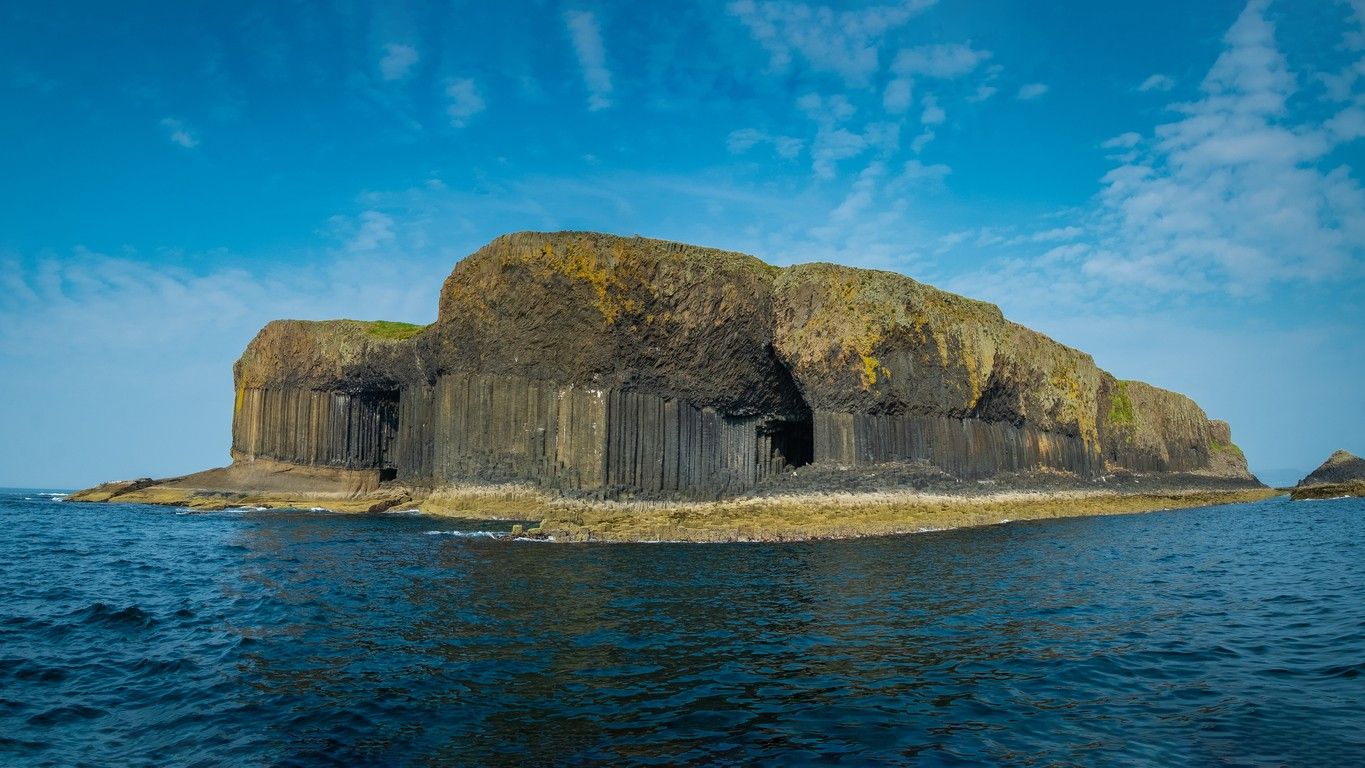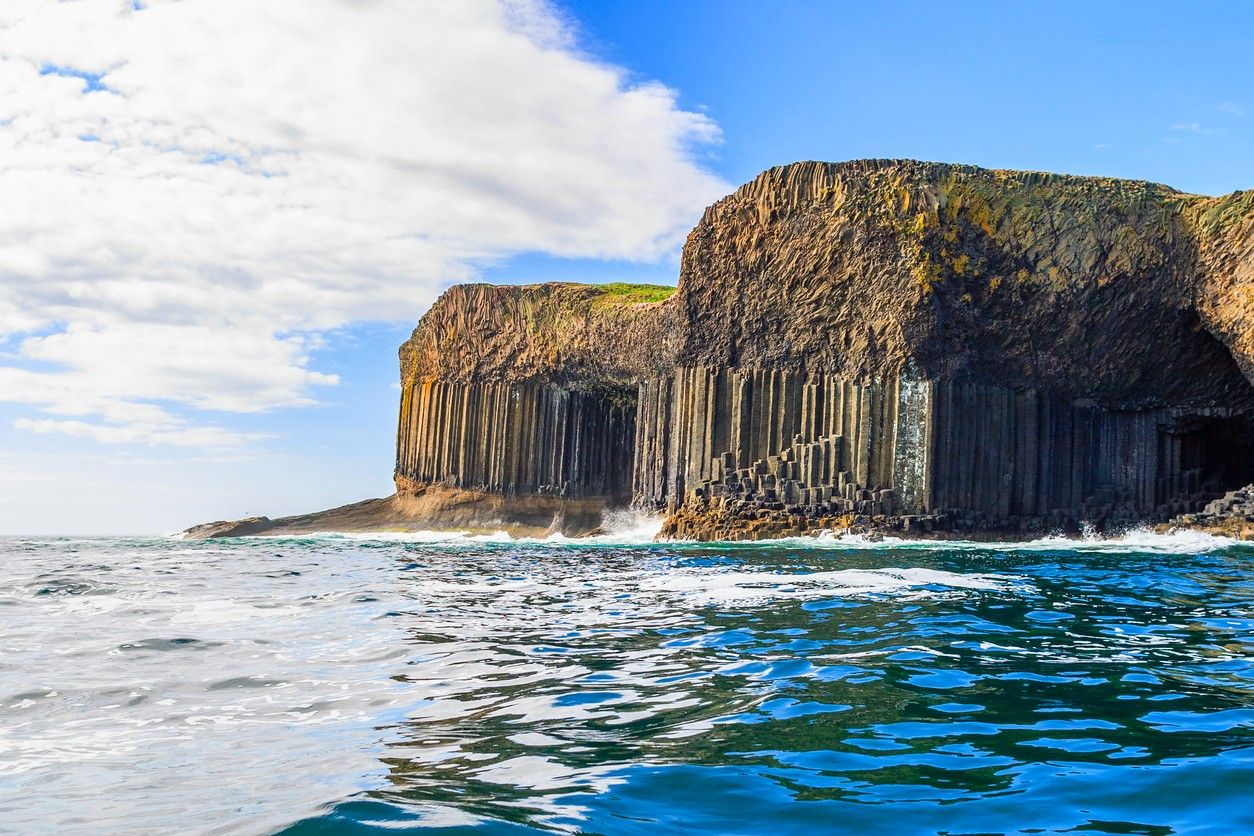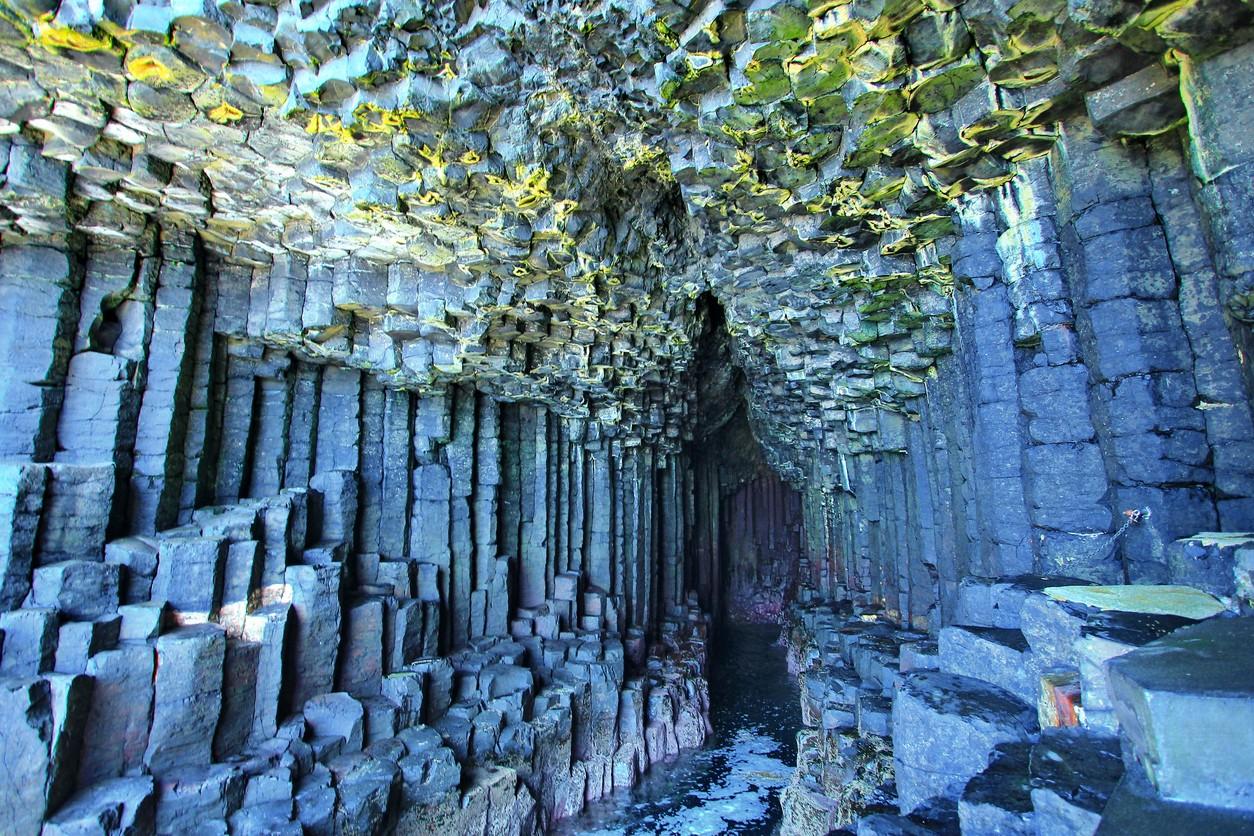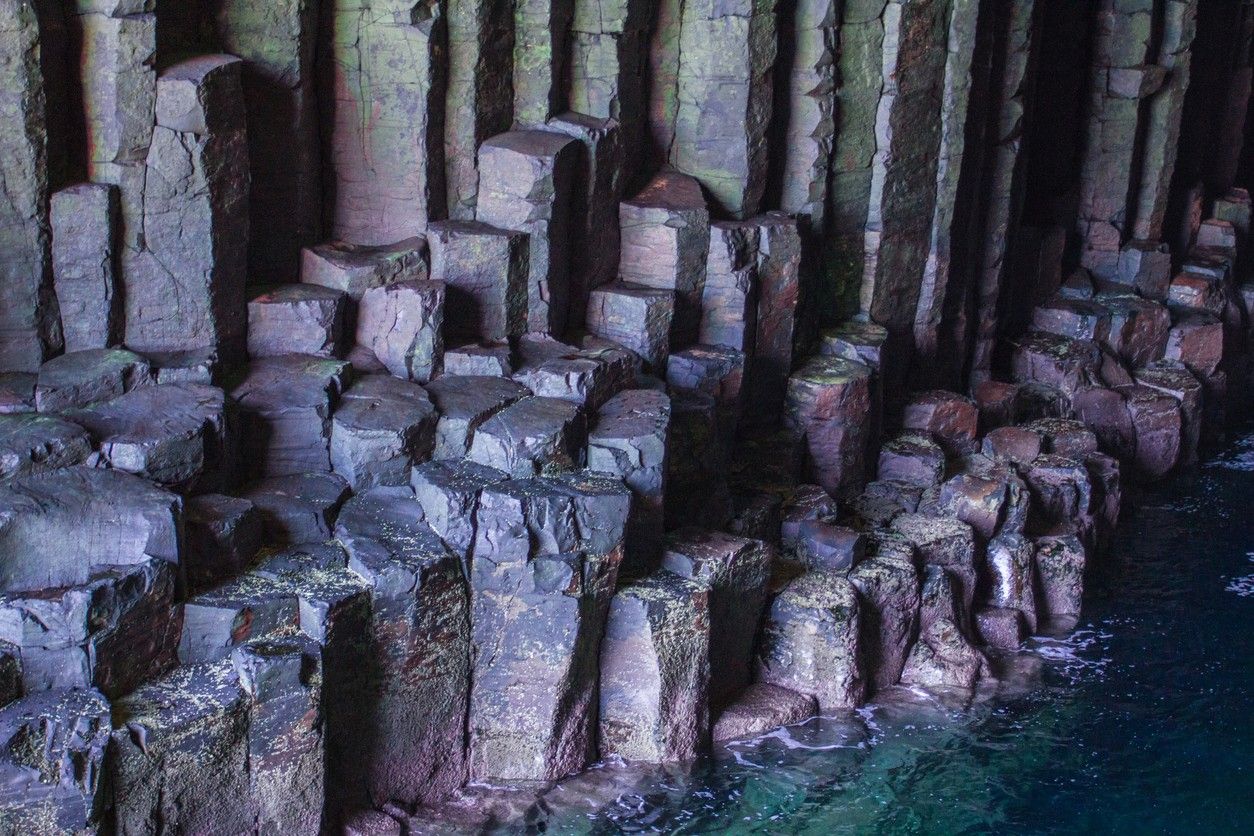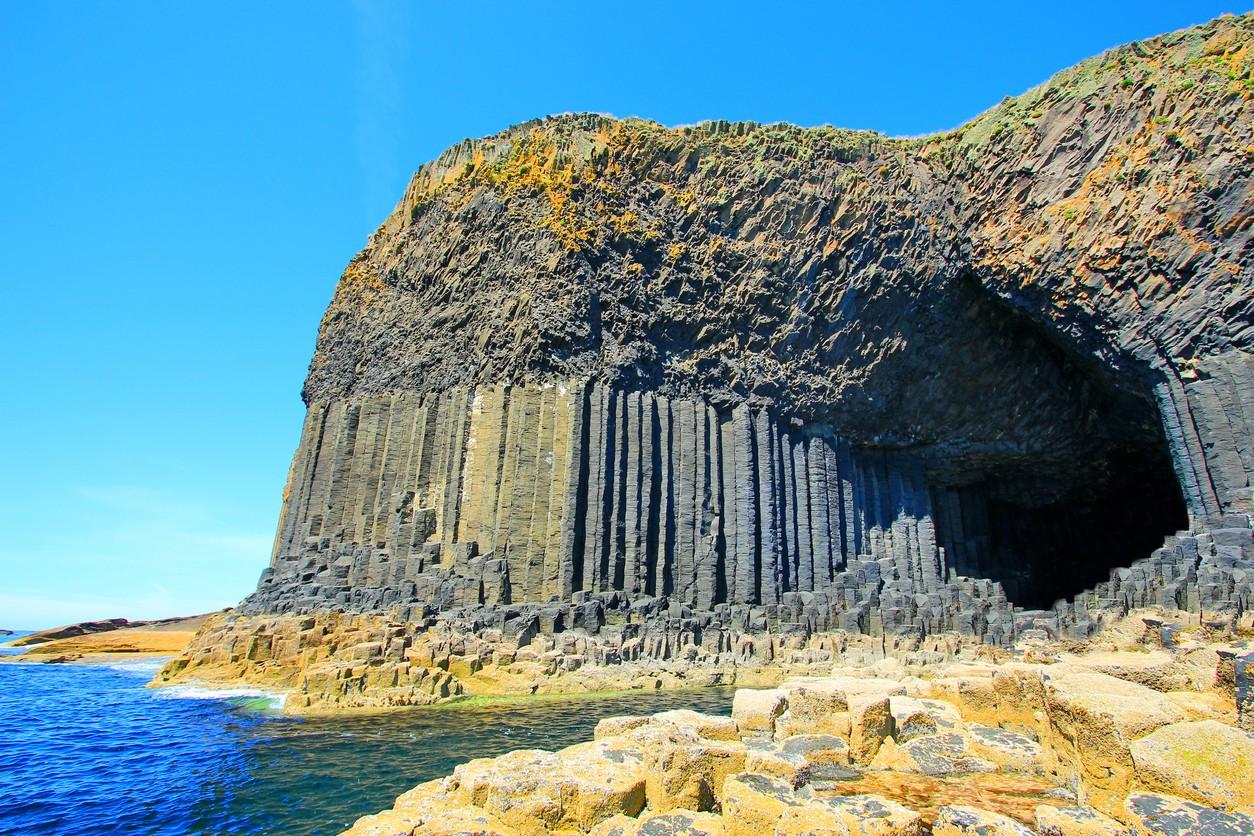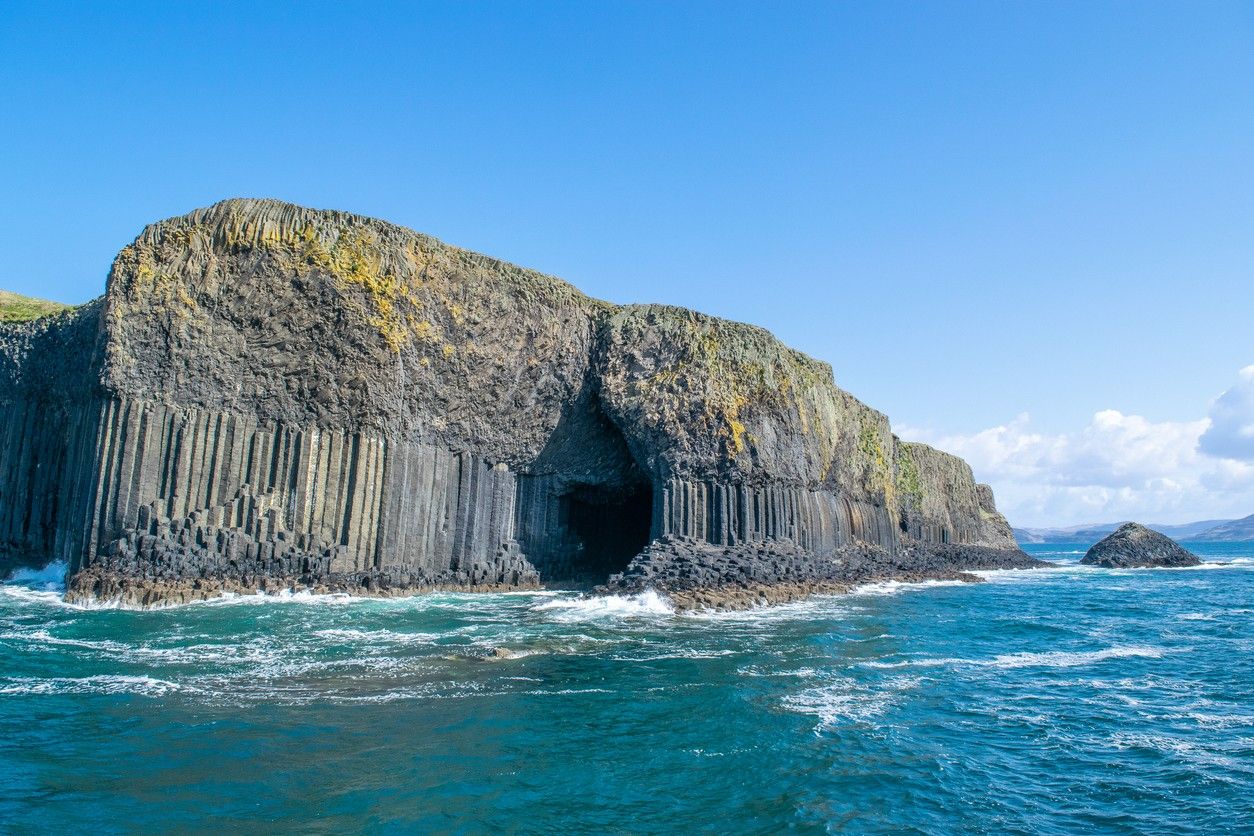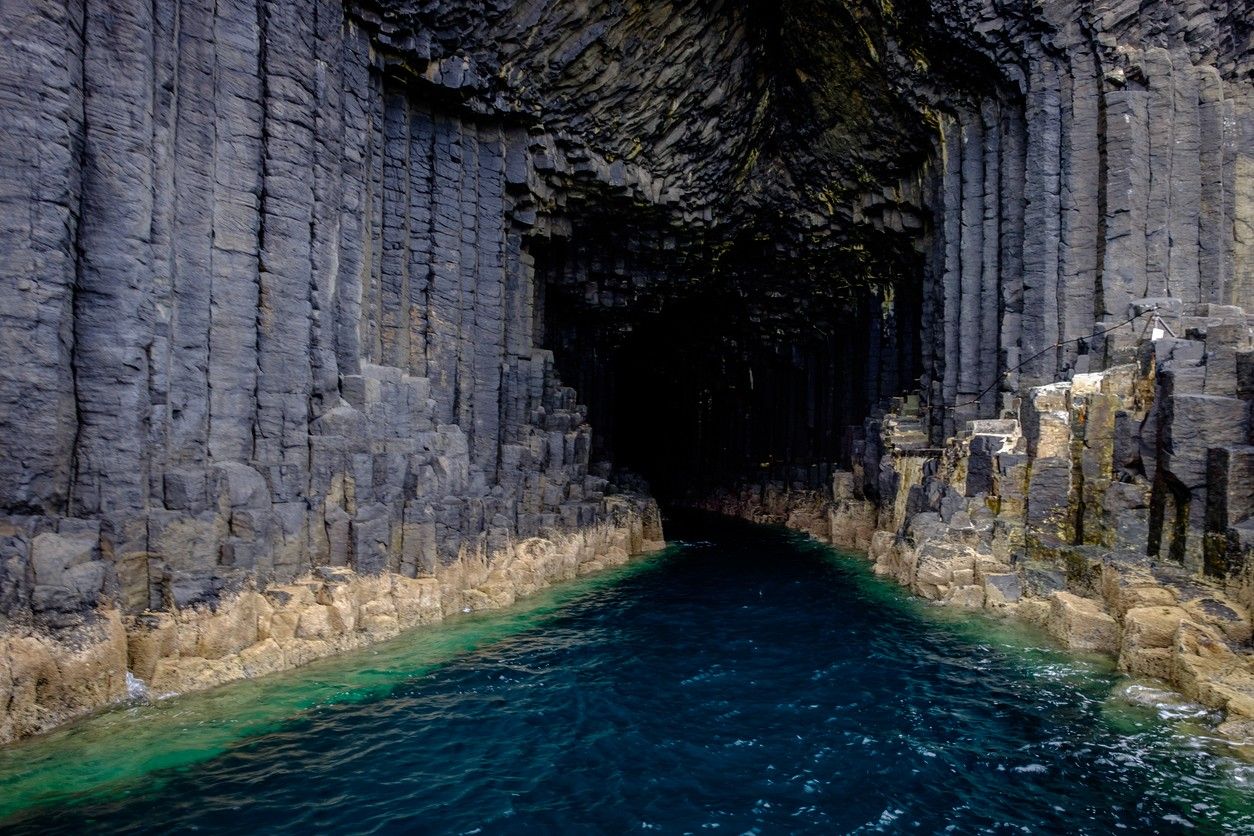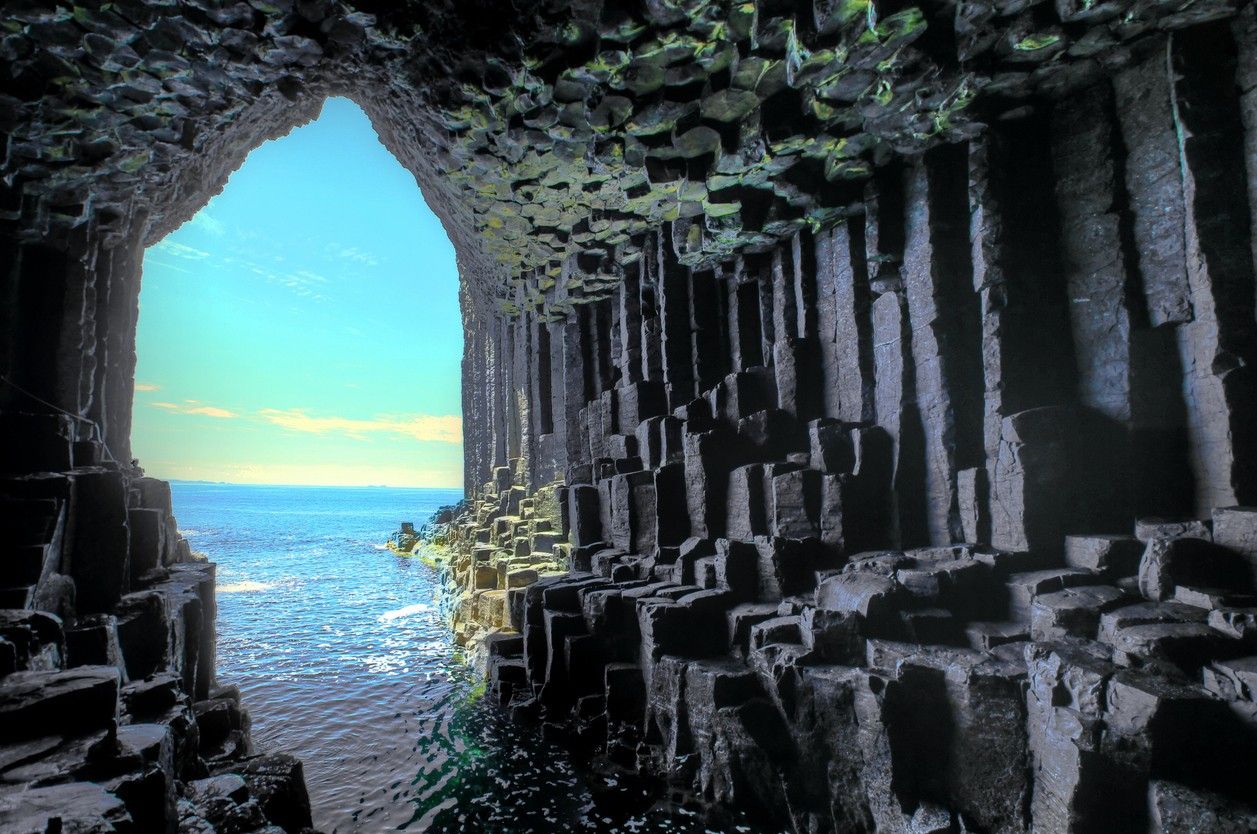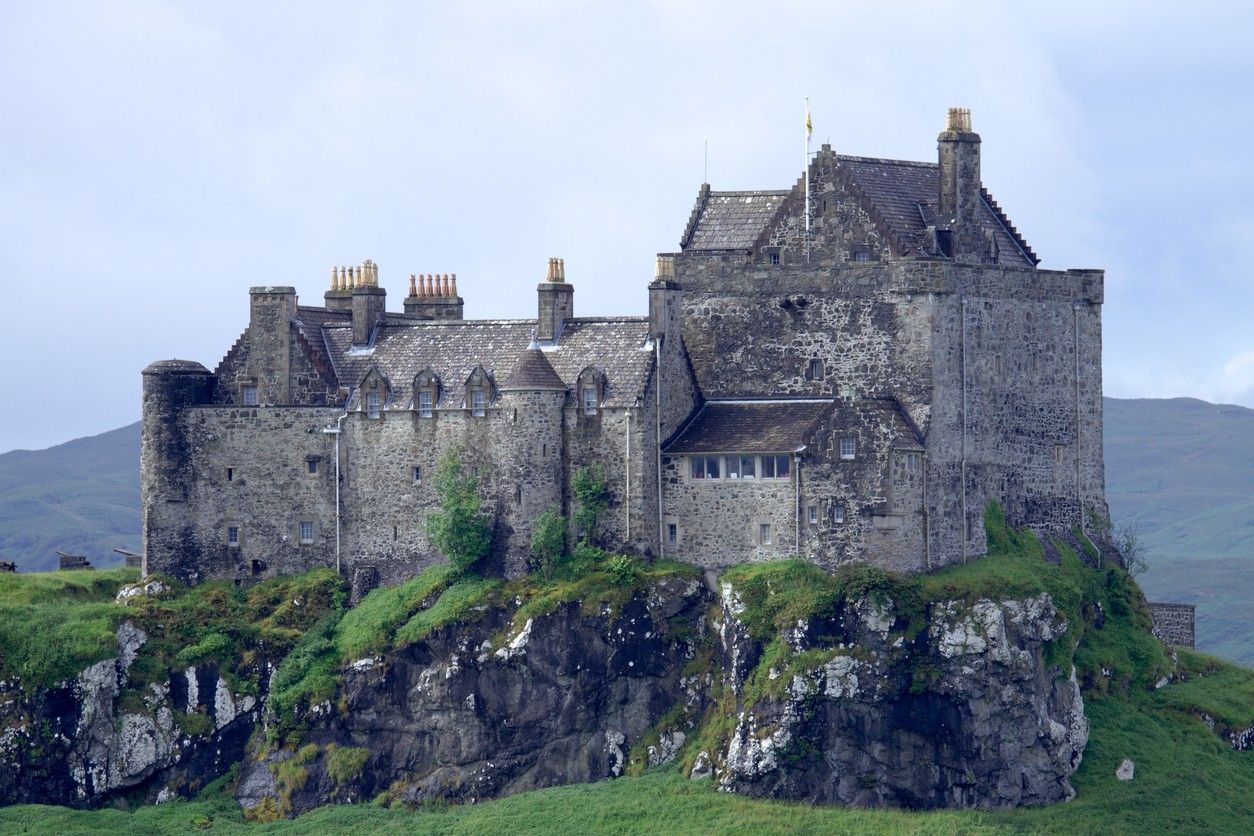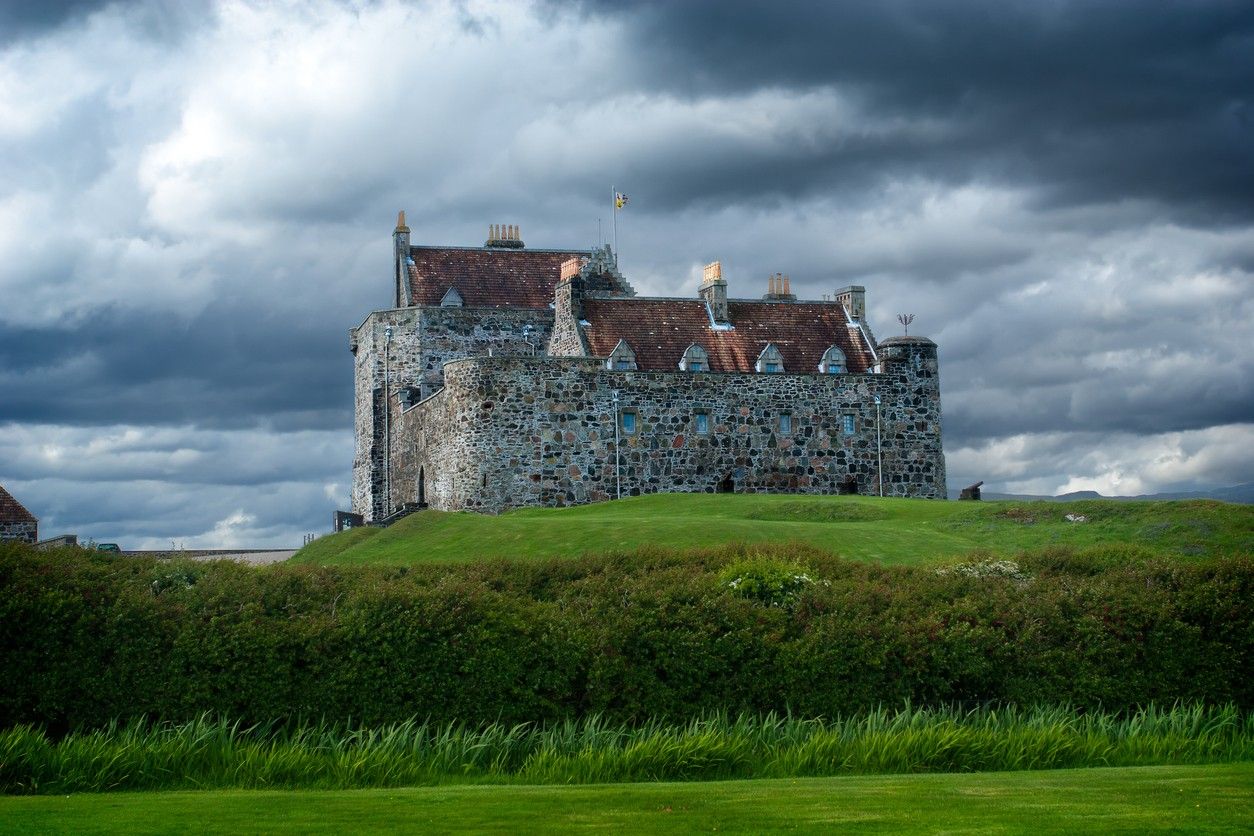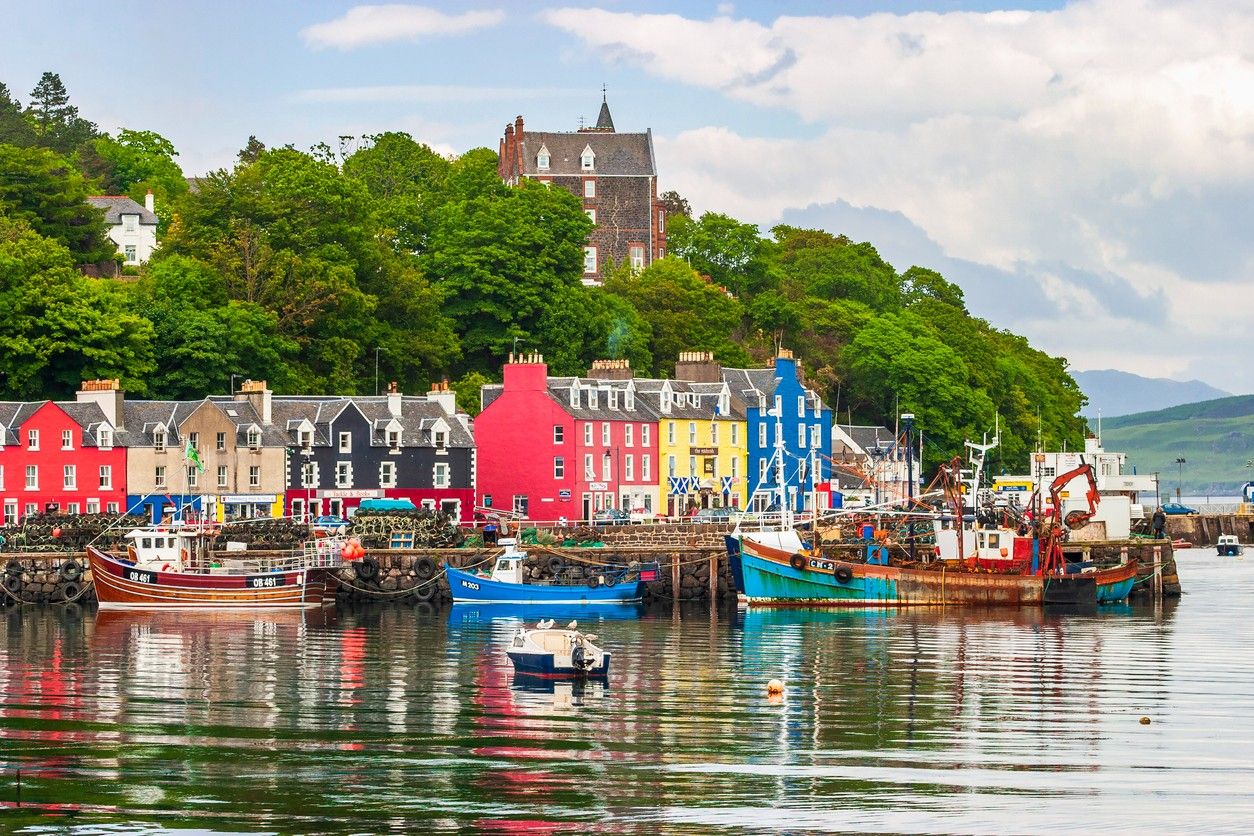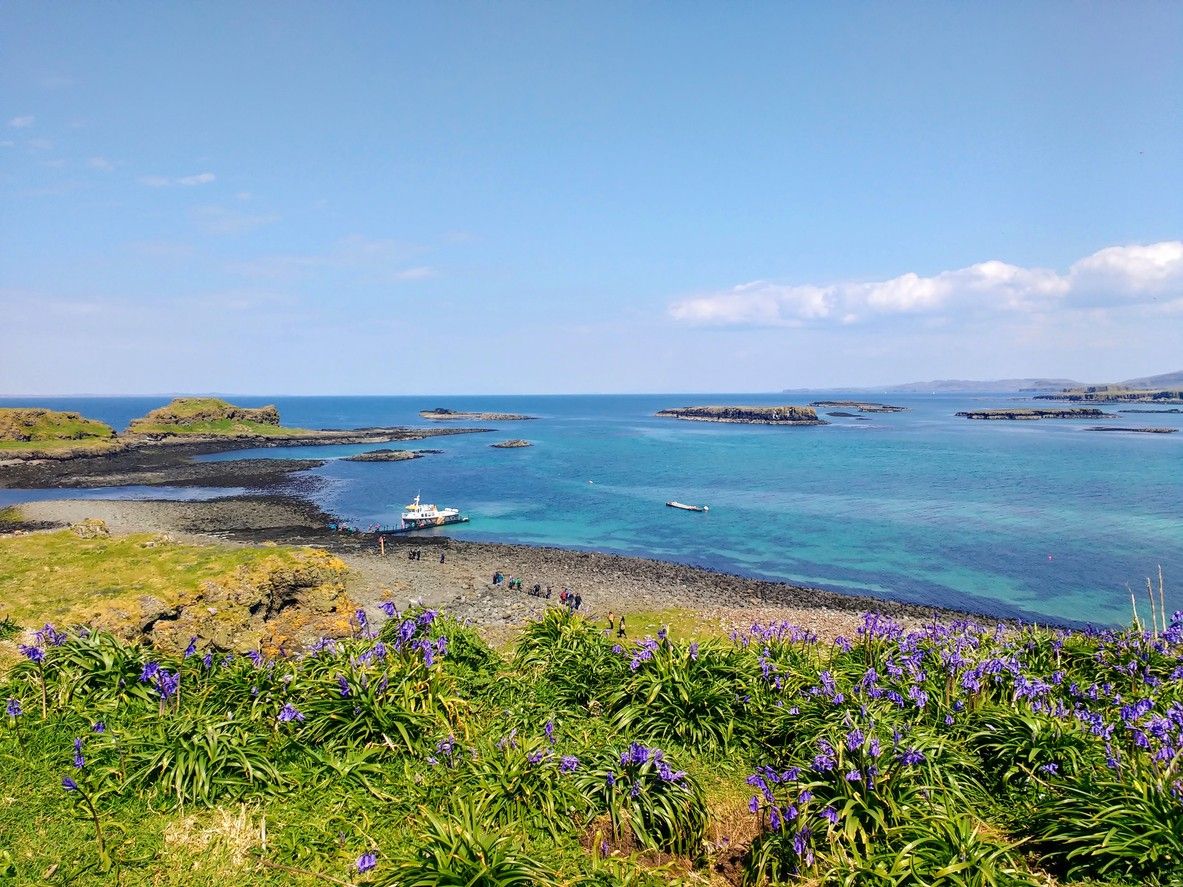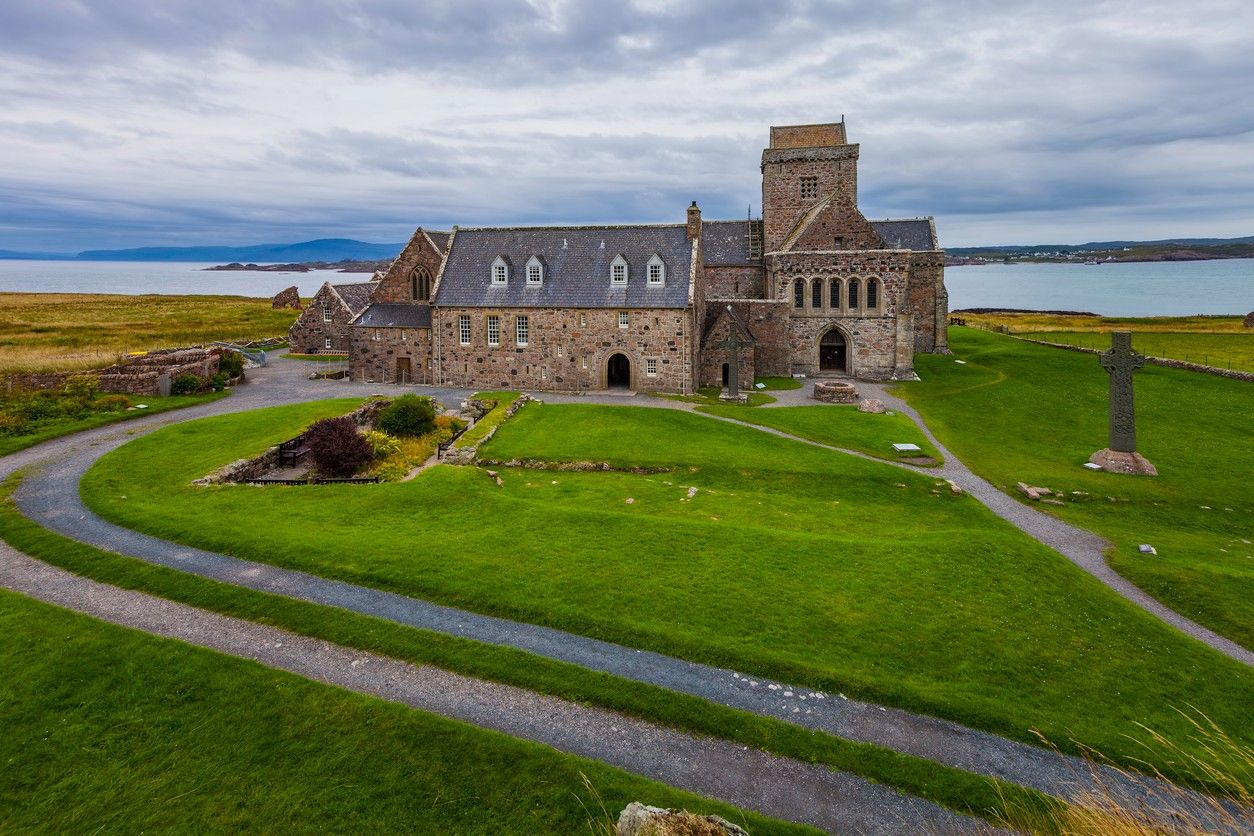Fingal's Cave, also known as Uamh-Binn in Scottish Gaelic, which translates to "cave of melody," is a remarkable natural wonder located on the uninhabited island of Staffa, off the west coast of Scotland. This stunning sea cave has captured the imagination of visitors for centuries, thanks to its unique geological features and the ethereal atmosphere created by the interplay of light, sound, and water within its chambers. Formed entirely from hexagonally jointed basalt columns, similar to those found at the Giant's Causeway in Northern Ireland, Fingal's Cave is a testament to the incredible forces of nature that have shaped our planet over millions of years. The cave's name is derived from the legendary Irish hero, Finn MacCool (known as Fionn mac Cumhaill in Irish mythology), who was said to have built a causeway between Scotland and Ireland. According to legend, Fingal's Cave was part of this causeway, and the distinctive hexagonal columns were the remains of MacCool's grand construction. While the mythical origins of the cave are a matter of folklore, the geological processes that formed this wonder are equally fascinating.
Fingal's Cave was created by ancient volcanic activity, which occurred around 60 million years ago. During this time, lava flows from the nearby volcanoes cooled and solidified, forming the distinctive hexagonal columns that make up the cave's interior. As the lava cooled, it contracted and cracked, creating the perfectly geometric pillars that have become the cave's hallmark feature. Over time, the relentless action of the waves has carved out the cave from these basalt columns, creating a cavernous space that stretches some 85 metres (279 feet) into the island's interior. The cave's natural acoustics are another feature that has contributed to its enduring appeal. The sound of the waves crashing against the basalt columns and echoing through the chambers creates a haunting, melodic atmosphere that has inspired countless artists, musicians, and writers over the years. The most notable of these is perhaps the German composer Felix Mendelssohn, who visited the cave in 1829 and was so moved by his experience that he composed the famous Hebrides Overture (also known as Fingal's Cave) in its honour.
The Incredible Geological Formation
Fingal's Cave showcases stunning columnar jointing, a geological feature formed by the cooling and contraction of ancient lava flows. As the lava cooled, it fractured into the distinctive hexagonal columns seen today. The cave's formation is a testament to the powerful volcanic activity that shaped the region millions of years ago.
Volcanic Activity & Columnar Jointing
Fingal's Cave and its stunning basalt columns are the result of ancient volcanic activity that took place during the Paleocene epoch, approximately 60 million years ago. During this time, the region that is now Scotland experienced intense volcanic activity, with lava flows covering large areas of the landscape. As the lava cooled and solidified, it underwent a fascinating process known as columnar jointing, which gave rise to the distinctive hexagonal columns that make up the cave's interior. Columnar jointing occurs when lava cools at a steady rate, allowing the rock to contract evenly in all directions. As the lava cools and contracts, it begins to crack in a regular pattern, forming the hexagonal shapes that are so characteristic of basalt columns. The size and shape of the columns are determined by factors such as the rate of cooling, the composition of the lava, and the presence of any impurities or irregularities in the rock.
In the case of Fingal's Cave, the lava that formed the columns was part of the larger Staffa Lava Formation, which extends across much of the region and includes other notable sites such as the Giant's Causeway in Northern Ireland. The lava that formed these columns was particularly uniform in composition, which allowed for the formation of the remarkably regular hexagonal shapes that make the cave so visually striking. The process of columnar jointing is not unique to Fingal's Cave and can be observed in many other locations around the world where volcanic activity has occurred. Some other notable examples include the Devil's Tower in Wyoming, the Devil's Postpile in California, and the Reynisfjara Beach in Iceland. However, the scale and beauty of the columns in Fingal's Cave are truly exceptional, making it one of the most impressive examples of this geological phenomenon in the world. The formation of Fingal's Cave and its basalt columns is a testament to the incredible power and beauty of the Earth's geological processes.
Basalt Columns & Mineral Composition
The basalt columns are composed of a type of volcanic rock known as basalt, which is rich in a variety of minerals that give the rock its distinctive dark colouration and physical properties. Basalt is an igneous rock that forms from the rapid cooling of lava on the Earth's surface and is one of the most common types of volcanic rock in the world, making up an estimated 90% of all volcanic rock on the planet. The mineral composition of basalt is primarily made up of plagioclase feldspar, pyroxene, and olivine. Plagioclase feldspar is a type of mineral that is rich in calcium and sodium and is responsible for the light-coloured flecks that can often be seen in basalt columns. Pyroxene and olivine, on the other hand, are darker in colour and contain higher levels of magnesium and iron, which give basalt its characteristic dark grey or black appearance. In addition to these primary minerals, basalt can also contain smaller amounts of other minerals such as magnetite, ilmenite, and apatite. These minerals can vary in concentration depending on the specific conditions under which the basalt is formed and can contribute to variations in the colour and texture of the rock.
One of the most striking features of the basalt columns in Fingal's Cave is their remarkable regularity and symmetry. The columns are typically hexagonal in cross-section, with each column being made up of multiple smaller columns that have fused as the lava cooled. The diameter of the columns can vary depending on the specific conditions under which they formed but typically range from a few centimetres to over a meter in size. The regular shape and size of the basalt columns are a result of how the lava cooled and contracted as it solidified. As the lava cooled, it began to crack in a regular pattern, with the cracks propagating downward from the surface of the flow. The hexagonal shape of the columns is a result of how the cracks intersect and the rock contracts, with the angles between the cracks being determined by the physical properties of the basalt itself. The mineral composition of the basalt also plays a role in the formation of the columns, with the presence of certain minerals affecting how the rock contracts and cracks as it cools. For example, the presence of high levels of iron and magnesium in the basalt can cause the rock to contract more strongly as it cools, leading to the formation of more pronounced and regular columns.
Erosion & Cave Formation
While the basalt columns of Fingal's Cave were formed by the cooling and contraction of ancient lava flows, the cave itself was shaped by the powerful forces of erosion over millions of years. The constant action of the waves and the relentless weathering of the rock have slowly carved out the cave from the surrounding cliffs, creating a stunning natural wonder that is both visually striking and geologically fascinating. The process of erosion that formed Fingal's Cave began almost as soon as the basalt columns had cooled and solidified. The columns, which are composed primarily of plagioclase feldspar, pyroxene, and olivine, are relatively soft and prone to weathering compared to other types of rock. As a result, they are easily eroded by the constant action of the waves, which slowly wear away at the surface of the rock over time.
In addition to the mechanical action of the waves, the basalt columns are also susceptible to chemical weathering, which occurs when the minerals in the rock react with water and other substances in the environment. This process can cause the rock to break down and dissolve over time, leading to the formation of cracks and fissures that can eventually widen into larger cavities and caves. In the case of Fingal's Cave, the process of erosion has been ongoing for millions of years, slowly carving out the stunning natural arch and the network of caves and caverns that lie beneath the surface. The cave itself is made up of several distinct chambers, each with its unique features and characteristics.
The largest and most impressive of these chambers is known as the "Great Hall," which measures over 20 meters in height and is lined with towering basalt columns that rise from the sea like the pipes of a giant organ. The acoustics of the Great Hall are particularly remarkable, with the sound of the waves crashing against the columns creating a haunting and ethereal echo that has inspired countless musicians and artists over the years.
Other notable features of the cave include the "Boat Cave," a smaller chamber that can be accessed by boat at low tide, and the "Clamshell Cave," a narrow passageway that is lined with curving walls of basalt that resemble the inside of a giant clamshell. The process of erosion that formed Fingal's Cave is ongoing, with the constant action of the waves and the weathering of the rock continuing to shape and reshape the cave over time. As a result, the cave is constantly evolving, with new features and characteristics emerging as old ones are worn away and transformed by the forces of nature. Despite the constant change and transformation that is occurring within the cave, the basic structure and layout of Fingal's Cave have remained relatively stable over the centuries. The towering basalt columns and the stunning natural arch that frames the entrance to the cave have become iconic symbols of the beauty and power of the natural world, and continue to inspire and amaze visitors from all over the world.
Cultural Significance and Artistic Inspiration
Fingal's Cave has captured the imagination of writers, poets, musicians, and artists for centuries. The unique geological features and dramatic setting have inspired works across various art forms, from paintings and sculptures to literature and music. The cave's cultural significance highlights the deep connection between geology, landscape, and human creativity.
Early Accounts & Popularisation
The ethereal beauty and geological wonders of Fingal's Cave have captivated the hearts and minds of visitors for centuries. The earliest recorded accounts of the cave date back to the late 18th century, when the Scottish Hebrides began to attract the attention of curious travellers, naturalists, and artists from across Europe. These pioneering explorers were drawn to the rugged, untamed landscapes of the islands, and their accounts of Fingal's Cave played a crucial role in popularising this natural wonder and cementing its place in the cultural imagination. One of the most influential early accounts of Fingal's Cave was written by the Welsh naturalist Thomas Pennant, who visited the island of Staffa in 1772. Pennant was struck by the grandeur and beauty of the cave, which he likened to a majestic cathedral crafted by the hand of nature. In his travelogue, "A Tour in Scotland and Voyage to the Hebrides," Pennant described the cave in vivid detail, marvelling at the towering basalt columns and the way the light played upon the water, creating an enchanting, almost supernatural atmosphere. His account captured the imagination of the British public and fueled a growing interest in the wild, romantic landscapes of the Scottish Hebrides.
In the years that followed, Fingal's Cave became a must-see destination for a new generation of travellers, artists, and writers who sought inspiration from the untamed beauty of the natural world. The English Romantic poet John Keats, who visited the cave in 1818, was deeply moved by the experience, later describing it as "a grand cathedral of the sea" in a letter to his brother. Keats' poetic account of the cave, with its evocative imagery and sense of awe, further contributed to its growing reputation as a place of sublime beauty and spiritual significance. As word of Fingal's Cave spread, it began to attract visitors from all walks of life, from aristocrats and intellectuals to artists and adventurers. The cave became a popular subject for painters and sketchers, who sought to capture its unique geological features and the interplay of light and shadow on the basalt columns. The Scottish artist William Daniell, who visited the cave in 1818, created a series of stunning aquatint engravings that brought the beauty of Fingal's Cave to a wider audience and helped to establish it as an iconic symbol of Scotland's natural heritage.
Perhaps the most significant moment in the popularisation of Fingal's Cave came in 1829 when the German composer Felix Mendelssohn visited the island of Staffa. Mendelssohn was so struck by the beauty and acoustics of the cave that he was inspired to compose his famous "Hebrides Overture," also known as "Fingal's Cave." This sweeping, evocative piece of music, with its soaring melodies and crashing waves, captured the essence of the cave and its surroundings and helped to cement its place in the cultural imagination of Europe and beyond. Through these early accounts and artistic interpretations, Fingal's Cave became a symbol of the romantic, untamed beauty of the natural world, and a source of inspiration for generations of artists, writers, and travellers. Today, the cave remains a powerful testament to the enduring allure of the Scottish Hebrides, and a reminder of the profound impact that the natural world can have on the human imagination. As visitors continue to flock to Staffa to marvel at the wonders of Fingal's Cave, they are following in the footsteps of the pioneering explorers and artists who first brought this extraordinary place to the attention of the world.
Artistic & Literary Influences
In the years that followed, Fingal's Cave became a popular destination for artists and writers seeking inspiration from the rugged beauty of the Scottish coastline. The English Romantic poet John Keats, who visited the cave in 1818, was particularly moved by the experience, describing it as "a grand cathedral of the sea" in a letter to his brother. The English painter J.M.W. Turner created a series of sketches and watercolours of the cave during a visit in 1831, capturing the play of light and shadow on the basalt columns and the swirling mists that often envelop the island of Staffa. In the 20th century, the American poet T.S. Eliot, who visited the cave in 1934, was particularly struck by its otherworldly atmosphere, describing it as "a place of strange enchantment" in his poem "The Dry Salvages."
Fingal's Cave has long been a source of inspiration for artists, musicians, and writers, who have been drawn to its unique beauty and otherworldly atmosphere. The cave's cultural significance can be traced back to the late 18th century when it first began to attract the attention of travellers and naturalists from across Europe. One of the earliest and most influential accounts of Fingal's Cave was written by the Welsh naturalist Thomas Pennant, who visited the island of Staffa in 1772. Pennant's description of the cave, which he likened to a grand cathedral, helped to popularise the site among the British public and sparked a wave of interest in the natural wonders of Scotland's western isles. In the years that followed, Fingal's Cave became a popular destination for artists and writers seeking inspiration from the rugged beauty of the Scottish coastline. The English Romantic poet John Keats, who visited the cave in 1818, was particularly moved by the experience, describing it as "a grand cathedral of the sea" in a letter to his brother.
Perhaps the most famous artistic work inspired by Fingal's Cave is the Hebrides Overture, a musical composition by the German composer Felix Mendelssohn. Mendelssohn visited the cave in 1829 and was so struck by its beauty and unique acoustics that he was moved to compose a piece of music that captured the essence of his experience. The Hebrides Overture, also known as Fingal's Cave, is a sweeping, melodic work that evokes the sound of the waves crashing against the basalt columns and the eerie echoes that reverberate through the cave's chambers. Mendelssohn's composition helped to cement Fingal's Cave's place in the cultural imagination and inspired countless other artists and musicians to create their works based on the cave's unique features and atmosphere. The English painter J.M.W. Turner, for example, created a series of sketches and watercolours of the cave during a visit in 1831, capturing the play of light and shadow on the basalt columns and the swirling mists that often envelop the island of Staffa. In the 20th century, Fingal's Cave continued to inspire artists and writers from around the world. The American poet T.S. Eliot, who visited the cave in 1934, was particularly struck by its otherworldly atmosphere, describing it as "a place of strange enchantment" in his poem "The Dry Salvages." Today, Fingal's Cave remains an important cultural landmark, attracting visitors from around the world who come to experience its unique beauty and draw inspiration from its natural wonders. The cave has been featured in numerous documentaries, films, and television programs, and continues to inspire new generations of artists and writers.
Fingal's Cave has also played a role in the local history and economy of the region. The island of Staffa, on which the cave is located, was once home to a small community of farmers and fishermen, who relied on the sea for their livelihoods. The cave itself was used as a shelter by these early inhabitants, providing a refuge from the harsh weather and rough seas that often batter the island. In the 19th century, the island of Staffa became a popular tourist destination, with visitors coming from around the world to see Fingal's Cave and the other natural wonders of the region. The development of steam-powered boats and the expansion of the railway network made it easier for tourists to reach the remote island, and by the late 19th century, Staffa had become a major attraction for Victorian travellers.
What to Visit Nearby
The Isle of Mull and its surrounding islands offer a wealth of natural and cultural attractions for visitors to explore. From the colourful harbour of Tobermory to the ancient Iona Abbey, there are numerous sites of historical and spiritual significance. The Treshnish Isles, known for their stunning wildlife and geological features, are another must-see destination. Visitors can also enjoy the isle's picturesque landscapes, thriving arts scene, and opportunities for outdoor activities.
Duart Castle
Duart Castle, situated on the Isle of Mull, is a magnificent example of a 13th-century Scottish castle that has withstood the test of time. The castle perches on a rocky promontory, commanding breathtaking views of the Sound of Mull and the surrounding coastline and islands. With a rich and captivating history spanning over 700 years, Duart Castle has been the ancestral home of the Maclean clan, one of Scotland's most prominent and influential families. The castle's origins can be traced back to the 13th century when it was constructed by the Macleans as a fortification to defend their lands and exert control over the crucial waterways surrounding the Isle of Mull. Throughout the centuries, successive generations of Macleans have left their indelible mark on the castle, expanding and renovating it to suit their needs and tastes. Duart Castle has an impressive curtain wall, which is a formidable defensive structure that encircles the castle, punctuated by several towers, including the imposing keep. This central tower stands at the heart of the castle, offering unparalleled views of the surrounding landscape and serving as a testament to the Macleans' power and influence.
Beyond its historical significance, Duart Castle is a stunning example of Scottish architecture and design. The skill and craftsmanship of the medieval stonemasons who built the castle are evident in every stone, while the interior of the castle showcases a range of exquisite period furnishings and decorations that transport visitors back to a bygone era. The castle's surroundings are equally enchanting, with visitors able to enjoy walks along the ramparts, taking in the breathtaking views, or strolling through the beautifully maintained gardens and woodlands that surround the castle. Throughout the year, Duart Castle plays host to a range of special events, from historical reenactments and music festivals to cultural celebrations, offering visitors a chance to immerse themselves in the rich heritage of the Maclean clan and the Isle of Mull.
Tobermory
Tobermory, the charming capital of the Isle of Mull, is a picturesque town renowned for its vibrant waterfront, where brightly coloured buildings line the harbour, creating a postcard-perfect scene. Nestled on the northeast coast of Mull, Tobermory overlooks the tranquil waters of the Sound of Mull and the nearby islands of Coll and Tiree, offering visitors a delightful blend of natural beauty, history, and cultural allure. The heart of Tobermory lies in its bustling harbour, a kaleidoscope of colours with buildings painted in a cheerful array of hues, from pastel pinks and yellows to bold blues and greens. This picturesque waterfront is a hub of activity, with fishing boats and pleasure crafts bobbing gently in the waters, while visitors and locals alike enjoy the many waterfront cafes, restaurants, and shops that line the harbour's edge. Strolling along Tobermory's Main Street is a delightful experience, with its charming independent shops, art galleries, and cafes beckoning visitors to explore and discover the town's unique character. From locally crafted goods and artwork to delectable Scottish cuisine, Tobermory offers a taste of the best that Mull has to offer, all set against the backdrop of a warm and welcoming community.
One of the most popular attractions in Tobermory is the Tobermory Distillery, a historic whisky producer that has been crafting exceptional malts since 1798. Visitors can embark on a guided tour of the distillery, learning about the time-honoured traditions and techniques that go into creating the perfect dram, and sample some of the distillery's finest whiskies, each with its own distinct character and flavour profile. For those interested in delving into the rich history and culture of the Isle of Mull, the Mull Museum is a must-visit destination. This fascinating museum showcases the island's storied past, from its ancient origins to its more recent history, including the pivotal role Mull played in the Jacobite Risings and the Highland Clearances. Through a carefully curated collection of exhibits and artefacts, visitors can gain a deeper understanding and appreciation of the island's unique heritage. Tobermory also serves as an ideal base for exploring the breathtaking natural beauty of the Isle of Mull. The town is surrounded by rolling hills, lush forests, and stunning coastlines, with a network of walking and hiking trails that offer visitors the chance to immerse themselves in the island's unspoiled landscapes and encounter its diverse wildlife.
One of the most popular walks from Tobermory is the Rubha nan Gall Lighthouse Walk, a scenic coastal route that leads visitors to a historic lighthouse, offering panoramic views of the Sound of Mull and the neighbouring islands. Another beloved trail is the Aros Park Circular Walk, a tranquil woodland path that winds through a diverse array of native trees and wildlife, providing a serene escape from the hustle and bustle of daily life. Throughout the year, Tobermory plays host to a vibrant calendar of cultural events and festivals, showcasing the best of Scottish music, arts, and heritage. From the lively Mull Music Festival in April to the enchanting Mendelssohn on Mull Festival in July and the thrilling Mull Rally in October, these events offer visitors a chance to experience the town's rich cultural tapestry and immerse themselves in the warm hospitality of the local community.
Iona Abbey
Iona Abbey, a beacon of spirituality and history, stands as one of Scotland's most significant religious sites. Nestled on the small island of Iona, just off the southwest coast of Mull, the abbey has been a place of pilgrimage and devotion for over 1,400 years, drawing visitors from all corners of the world to experience its profound beauty and serenity. The story of Iona Abbey begins in 563 AD, when St. Columba, an Irish monk, embarked on a mission to bring Christianity to the people of Scotland. Arriving on the shores of Iona with a small group of followers, St. Columba established a modest monastery, built from wood and thatch, which would become the foundation for the abbey that stands today. As word of St. Columba's teachings and the monastery's sanctity spread, Iona quickly grew into a thriving centre of learning and religious devotion, attracting scholars and pilgrims from across Europe.
Throughout its long and storied history, Iona Abbey has faced numerous challenges and triumphs. In the 9th century, the monastery fell victim to a devastating Viking raid, leaving it in ruins. However, the indomitable spirit of the monks and the enduring faith of the community saw the abbey rebuilt and expanded, time and time again. By the 12th century, Iona Abbey had become a major pilgrimage site and a focal point for religious learning, its influence extending far beyond the shores of Scotland. Today, visitors to Iona Abbey are greeted by a magnificent example of medieval architecture, a testament to the skill and devotion of the monks who called this sacred place home. The abbey church, dating back to the 12th century, is a stunning example of Romanesque design, with its imposing stone walls, intricate carvings, and soaring arches that seem to reach towards the heavens. Within the church, visitors can explore a treasure trove of historical artefacts and works of art, from the exquisitely carved high altar, dating back to the 15th century, to the breathtaking stained glass windows that depict scenes from the life of St. Columba and other revered religious figures.
The Treshnish Isles
The Treshnish Isles, a hidden gem nestled off the west coast of Mull, are a captivating archipelago renowned for their untouched natural beauty, diverse wildlife, and fascinating geological features. These uninhabited islands, designated as a Site of Special Scientific Interest and a Special Protection Area, serve as a sanctuary for an astonishing array of plant and animal species, offering visitors a rare glimpse into the unspoiled wonders of the Scottish Hebrides. Each of the islands that make up the Treshnish Isles boasts its unique character and allure. From the towering sea cliffs and lush, grassy slopes of Lunga to the rugged, windswept coastline and secluded coves of Fladda, these islands are a testament to the raw power and beauty of nature, untouched by the hand of man. The islands of Bac Mòr and Cairn na Burgh Mòr complete this enchanting archipelago, each with its distinctive landscape and hidden treasures waiting to be discovered.
For wildlife enthusiasts, the Treshnish Isles are a true paradise, offering an unparalleled opportunity to observe a wide variety of seabirds in their natural habitat. During the breeding season, the islands come alive with the sights and sounds of thousands of puffins, guillemots, razorbills, and kittiwakes, as they nest on the rocky cliffs and shorelines. The sight of these majestic birds soaring through the air, diving into the crystal-clear waters, and tending to their young is an unforgettable experience that will leave visitors in awe of the wonders of the natural world.
To fully immerse themselves in the magic of the Treshnish Isles, visitors can embark on a boat trip from Mull, guided by knowledgeable local experts who are passionate about sharing the islands' secrets and stories. As you approach the islands, the true scale and majesty of the seabird colonies become apparent, with the air filled with the cacophony of bird calls and the gentle lapping of waves against the shore. These guided tours offer a unique opportunity to learn about the intricate ecosystems of the islands, the behaviour and habits of the resident seabirds, and the conservation efforts in place to protect these precious habitats. Beyond the seabirds, the Treshnish Isles are home to a rich tapestry of other wildlife, from the playful seals and otters that frolic in the waters surrounding the islands to the majestic dolphins that occasionally grace the area with their presence. The waters themselves are teeming with an abundance of marine life, including a diverse array of fish, crustaceans, and other sea creatures that form the foundation of the island's delicate ecosystems.
Planning Your Visit to Fingal's Cave
Choosing a Tour Operator
When planning a visit to Fingal's Cave, the first step is to choose a tour operator that offers trips to the island of Staffa. Several companies operate boat tours from the nearby islands of Mull and Iona, with most offering a range of options to suit different budgets and interests. Some tours focus solely on Fingal's Cave, while others include stops at other nearby attractions, such as the Treshnish Isles or the island of Iona. When selecting a tour operator, consider factors such as the size and type of boat, the length of the tour, and the level of amenities provided. It's also essential to check the tour operator's safety record and read reviews from previous customers to ensure that you're choosing a reputable and reliable company.
Travel and Transportation
Once you've chosen a tour operator, you'll need to plan your travel to the departure point. Most tours depart from the town of Fionnphort on the island of Mull, which can be reached by ferry from the mainland town of Oban. There are also a few tours that depart from the island of Iona, which can be reached by ferry from Fionnphort. When planning your travel, allow plenty of time to reach the departure point, as ferry schedules can be subject to change due to weather conditions. It's also advisable to book your tour in advance, especially during peak season, to ensure that you secure a spot on your preferred date and time.
Related Articles

Let us know you agree to cookies
We use marketing, analytical and functional cookies as well as similar technologies to give you the best experience. Third parties, including social media platforms, often place tracking cookies on our site to show you personalised adverts outside of our website.
We store your cookie preferences for two years and you can edit your preferences via ‘manage cookies’ or through the cookie policy at the bottom of every page. For more information, please see our cookie policy.
